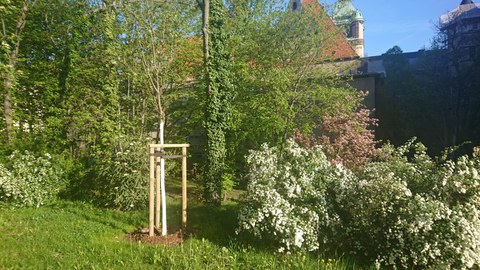Tree sponsorship Prof. em. Dr.-Ing. Peer Haller Bird Cherry
- Scientific name
- Prunus padus
- Planting
- January 2024
- Tree sponsor
-
Prof. em. Dr.-Ing. Peer HallerChair of Timber Engineering and Building Structural Design
- Handed over on
- May 31, 2024
In close connection to TU Dresden, Professor Haller donated a Bird-Cherry tree and a Red-flowering horse chestnut tree on the occasion of his retirement.
Location
Did you know?
The European bird cherry (Prunus padus) is a native deciduous tree that reaches 10-15 meters in height. The species can live up to 80 years.
The white, cup-shaped flowers appear in early spring before the leaves and emit an intense honey-like fragrance that attracts honey bees, wild bees and hoverflies. The leaves of the bird cherry are a popular caterpillar food source for more than 30 butterfly species (day butterflies, swallowtails, etc.). For birds, the ripe black cherries, the pea-sized black stone fruits are an important autumn and winter food source. The bird cherry is a popular ornamental tree or shrub and an ecologically valuable species.
The Red-flowering horse chestnut (Aesculus carnea) is a deciduous tree that grows up to 20 meters tall. The species is a cross between the Balkan horse chestnut (Aesculus hippocastanum) and the North American red horse chestnut (Aesculus pavia). The tree blooms from mid-May to June. The flowers are bright red and a good food source for insects. The spherical capsule fruits are almost smooth, with only a few spines and slightly smaller than those of the common horse chestnut. The fruit contains two to three small, dull brown seeds.
Unlike the common horse chestnut (Aesculus hippocastanum), the red-flowering horse chestnut is not damaged by the larvae of the horse chestnut leaf miner (Cameraria ohridella), so the leaves appear in full splendor until autumn. The species is often planted as a solitary tree, in alleys and in parks.

